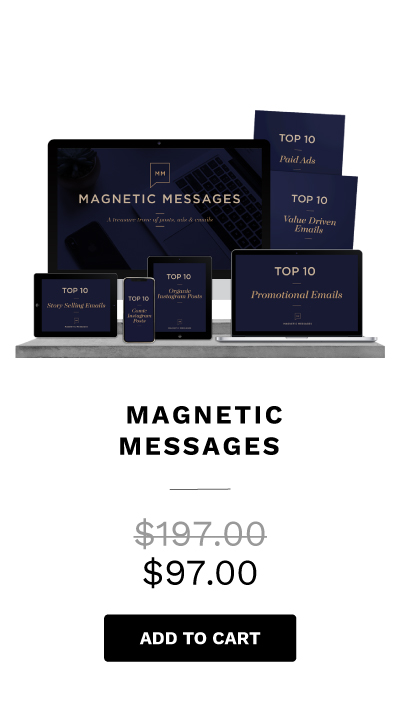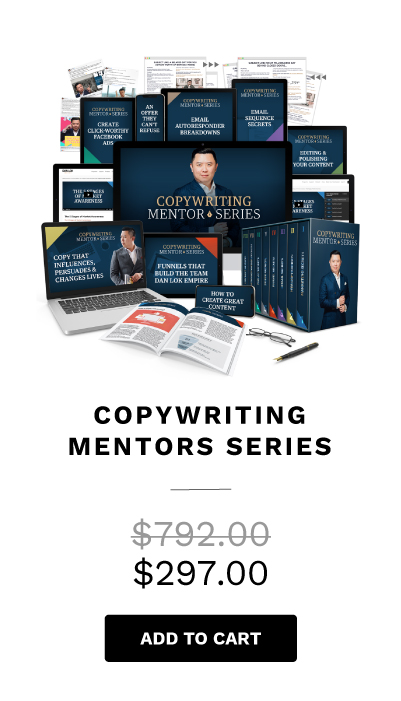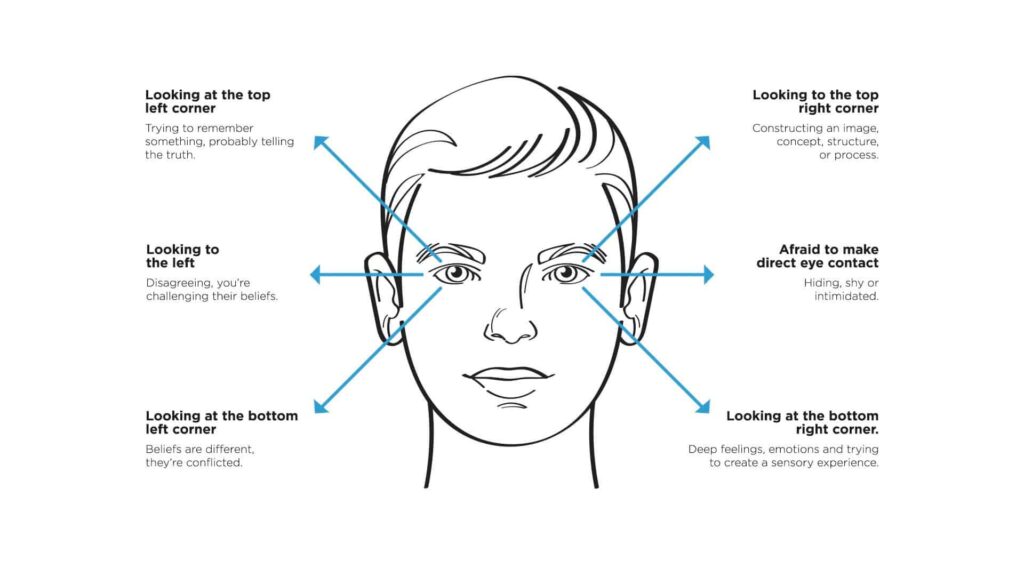Is there any feeling more heart-warming than that of settling down to watch one of your favourite Disney movies from childhood? There are two things that might feel even better: Watching a clever and entertaining remake of your favorite childhood classic, and making billions of dollars.
Disney is doing it right, having made over $2 billion off remakes in the first seven months of 2019 alone, with the three live-action remakes of Disney classics released this year. Dumbo grossed over $350 million since its March 2019 release.
May’s remake of Aladdin has grossed over $1 billion, and even features A-list actor Will Smith as the genie. Most recently, July’s The Lion King (a remake of the 1994 classic film) has already grossed a whopping $1 billion in less than 3 weeks.
Did you know that Disney actually broke a world record this year, with their colossal box office sales? Before we get to that, Let’s talk in general terms for a minute.
In general, very few films will ever earn $1 billion at the box office, and yet Disney has already done it four times in 2019 alone. That’s right: The Lion King is Disney’s fourth billion-dollar film this year.
Other Disney films that have grossed $1 billion at the box office this year include Avengers: Endgame, Captain Marvel and Disney’s live action remake of Aladdin.
The impressive sales from Disney movie remakes this year is not a fluke. Disney has been thriving on this business strategy of nostalgia marketing for several years now. 2010’s Alice in Wonderland, 2016’s The Jungle Book and 2017’s Beauty and the Beast each earned over $1 billion.
Remember what I said earlier, about how rare it is for any movie to cross that $1 billion mark? It really makes you wonder what Disney’s secret formula is.
In less than a decade, Disney has amassed more than $7 billion in revenue from its remakes of classic Disney movies. Click To TweetIf you include Disney’s other productions, such as their film adaptations of childhood comics, then Disney has actually amassed over $7 billion at the box office this year alone. It isn’t just the box office where Disney scores, though.
Revenue also streams in from cross-promotion with other brands and through related Disney products such as toys, food, and clothing with trademarked images of popular Disney characters.
Selling a Feeling
Let me ask you something: What do you think the secret to Disney’s success is? You probably already know that successful marketing involves selling a feeling. Lately, it seems like selling the feeling of nostalgia is the path to success. This is what’s known as nostalgia marketing, and believe me, it works.
So, what do products that evoke emotion and nostalgia (such as a remake of a beloved childhood classic) actually accomplish?
These products produce gratifying emotional experiences that drive customer loyalty, positive perceptions of the brand, and lots of purchases.
Nostalgia marketing appeals to our wish to return to an easier, simpler time with less responsibilities and more acceptance. Disney has been capitalizing on this emotional desire by bringing audiences films that connect us to our past while providing a modern spin for novelty and entertainment value.
With Disney looking ahead to a full slate of remakes in the near future, let’s explore why nostalgia marketing is so lucrative, and how this strategy could be used in other industries, by other companies:
Disney: King of the Box Office
The sheer genius of Disney’s marketing strategy is proven in its record-breaking box office sales. The Lion King, released July 19th of this year, was the highest domestic opening for a Disney remake so far, beating out Disney’s past mega-successes like Beauty and the Beast.
Disney didn’t just beat itself – The Lion King was in fact the biggest July film opening of all time. It is no surprise that Disney plans to continue with this strategy of nostalgia marketing.
Remakes in the works include: a sequel to Maleficent coming out later this year, a reboot of Mulan, and then there’s Cruella which is based on the Disney classic 101 Dalmatians set for next year. Remakes of Pinocchio, The Little Mermaid, Peter Pan, and others are also in progress.
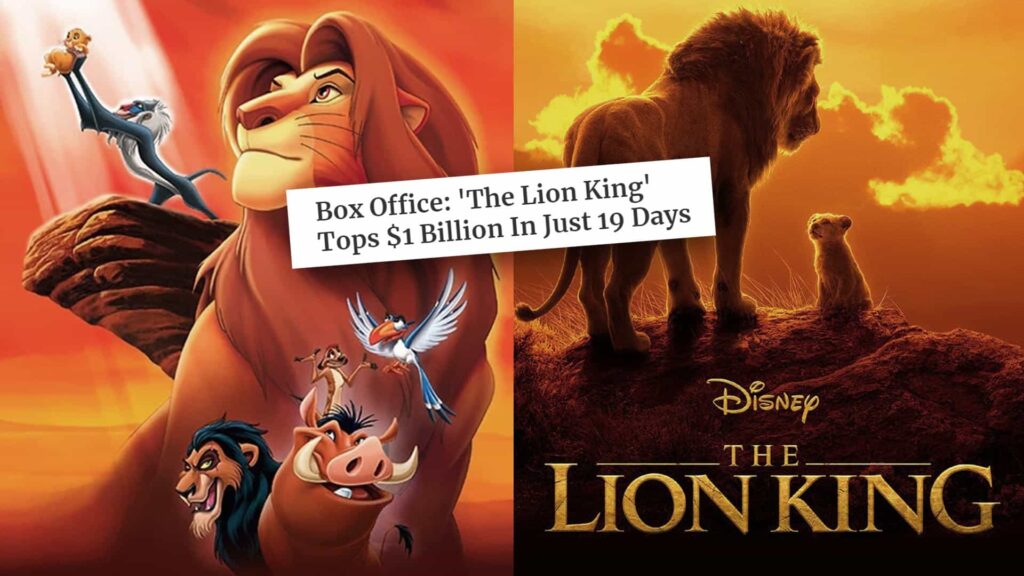
Disney is using a brilliant combination of nostalgic stories, celebrity actors and voice actors, and multi-level marketing to soar to the top of the box office.
The strategy of reviving classics works by creating an ongoing relationship of customer loyalty through nostalgia is working.
Audiences want to share these classic and re-made films with others, and re-live these cherished stories and characters through the modern remakes as well as through products and experiences like Disneyland.
Movie remakes pull at the heartstrings of many.
For example, there are Gen X parents who grew up watching the classic versions of these films. Parents will want to bring their children to see the remake, to enjoy a shared experience and show their children the stories they loved as a child.
Millennials, on the other hand, still remember the childhood classics fondly, and they get to re-live it when Disney releases a remake, which is exciting for them.
Some millennials not only watched the original version of the films over and over again as children, but even dressed up as their favorite Disney characters for Halloween, whether they dressed up as Aladdin or Princess Jasmine from Aladdin or Belle from Beauty and the Beast. It doesn’t get much more nostalgic than that.
For younger viewers, these remakes could be their first exposure to the brand and story, and the nostalgic aspect may be lost on them, but they can still be aware of the hype of memory and sentimentality from those who do remember the originals.
In this way, remakes can appeal to multiple generations and be a shared collective experience within families and society.
The key to Disney’s use of nostalgia marketing is that they are doing more than simply repackaging the original movie.
They are creating a modern and engaging new experience with the incredible digital animation technology available today.
And because a little Beyonce makes everything better, Disney’s use of high-profile celebrity actors and voice actors is adding to the hype and excitement.
Sean Bailey, co-President of Disney, told Vulture magazine in 2017 “Maybe if there’s a way to reconnect with that affinity for what those characters mean to people in a way that gets the best talent and uses the best technology, that could become something really exciting. It feels very Disney, playing to the competitive advantages of this label.”
There is no doubt that Disney’s approach is working: the 11 remakes that they have made since 2010 have grossed over 7 billion dollars.
Who Loves Remakes, and Does Anyone Hate Them?
We can imagine that Disney is more than pleased with their profits, but how is the public responding to this slate of remakes? The answer is mixed, because where there is love and excitement, there are always haters as well. Given the box office successes, it is obvious that huge numbers of the population are eager to fork over their hard-earned dollars to see these new reboots.
The movie industry isn’t what it used to be, with the increasing cost of movie tickets and the competition from Netflix and other streaming services, but people seem to be keen on seeing Disney movie remakes in theatres.
Clearly the ticket sales speak to a great deal of public enthusiasm, but why? For many, there is a thrill in getting to see an updated version of a classic, re-imagined with celebrities they know and love as well as eye-popping 3D animation.
So, what are the haters saying?
We can’t acknowledge the enthusiasm without acknowledging the hate, since every brand will have its haters. In Disney’s case, some people are more skeptical about the trend of remakes, seeing it as a cynical ploy by Disney to make easy money by rehashing tested and true stories rather than taking the risk of coming up with new content.
One fan writes about The Lion King remake, “the rhythms of African drums were drowned out by the sound of Disney cashing checks” and later said they were left feeling used for their fandom.
Much of the fan backlash centers around this sense that Disney is being “lazy” and that remakes are just a cash grab. Some disappointed fans on Reddit have complained, ”the lack of new, original ideas is frightening”.
Others have defended Disney, or at least pointed out that the trend of remakes in not surprising, as ”Disney has always been about adapting, not making original content.
This is just them doing what they always have done.” Another Reddit user points out how many classic Disney films like Alice in Wonderland were not original to begin with, and were adaptations of old legends and folktales.
In other words: modernizing, repurposing and enhancing old stories is nothing new for Disney, and it’s indisputable that this strategy works.
Many of Disney’s ‘haters’ still did fork over their money to see the remake simply out of curiosity – and therefore added to Disney’s profits. Go figure.

The Role of Emotion in Your Purchasing Decisions
Let’s talk about emotion, and the role it plays in your decision to actually make a purchase. When you make a decision to buy a product, or to buy a ticket to see a film in theatres, what do you think influences your decision-making process?
Many of us see ourselves as being rational actors, making our choices from a thoughtful, calculated place. It may come as some surprise then, that according to a recent study by neuroscientist Antonion Damasio, approximately 85 percent of our decisions are driven by emotion.
If you were to look back at the purchasing decisions you made this week, in hindsight you might realize the emotional forces that were unconsciously at work. You might even recognize exactly which emotions were at play when you were making certain purchases.
If 85 percent of our decisions are driven by emotion, then it makes perfect sense why Disney’s strategy of nostalgia marketing works. Click To TweetThis statistic from Damasio shows us something very important: In order for marketing to be persuasive, it will require an emotional trigger.
In light of this, successful marketers in any business must know how to tap into the emotional states of their target customers, because pressing a prospect’s emotional buttons could result in a sale.
For a customer to be willing to purchase a product, spend a higher price on a different product, or purchase it repeatedly and become a loyal customer, it is essential to build an emotional connection to the product or brand.
According to a 2016 study from Ju, I., Kim, J., Chang, M. J., & Bluck, S. entitled Nostalgic marketing, perceived self-continuity, and consumer decisions, experiential marketing uses atmosphere and associated emotions to sell a product, rather than just relying on the material or quantifiable properties of the product itself.
While emotional in general is the primary driver in purchasing decisions, one emotion in particular has come to attention as a marketing powerhouse: nostalgia.
Nostalgia: A Powerful Emotional Driver in Today’s Marketplace
Have you ever noticed that some of your favourite songs – the ones that evoke the most emotion when you hear them – happen to be the songs you loved in your teens or early 20s, rather than your latest modern favorites? Despite having perhaps discovered “better” music since adolescence, for some of us nothing beats how we feel when we hear a classic hit from the ’90s.
This emotional response makes sense, based on the research into nostalgia from Psychologist Petr Janata, who in an interview with Slate, stated that our musical preferences are “consolidated into the especially emotional memories from our formative years.”
Our favourites and tastes are formed as a teenager and young adult, so products that harken back to that time of life are most likely to create a positive emotional state and draw us towards the brand.
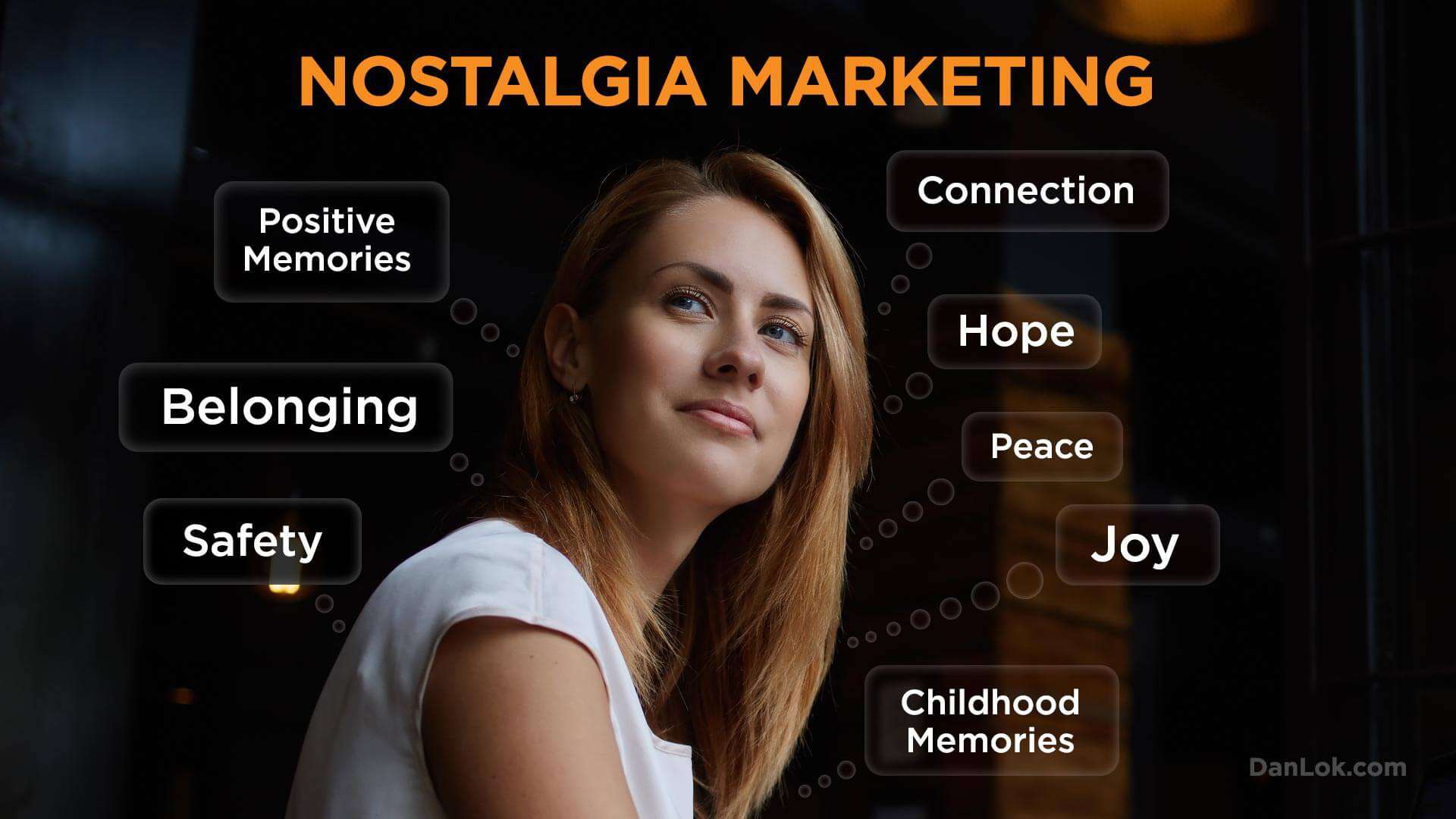
For millennials who grew up in the 1990s and early 2000s, any product or entertainment that reminds them of that era will evoke nostalgia and positive feelings.
This explains why Disney films like The Lion King, Aladdin, and The Jungle Book (all of which were originally released in the mid-1990s) will appeal to millenials and younger Gen-Xers as remakes today.
If you remember watching these Disney classics as a child, then even just seeing the trailer of the remake might bring you back to a Friday night when your parents let you eat pizza in your pajamas and watch The Lion King with your friends. This is how nostalgia marketing works.
Nostalgia marketing aims to remind you of your youth, a simpler time, and it stirs up the longing for the feelings you associate with that time: Safety, belonging, connection, hope and joy.
Is it any wonder why these nostalgic Disney films and products are so enticing?
You might still be wondering exactly how nostalgia works so effectively as a marketing strategy. An increasing amount of research has been done on this exact question.
Nostalgic products bring up a sense of what Hartmann and Brunk’s research from 2019 Nostalgia marketing and (re-)enchantment refer to as “a sense of enchantment” meaning exciting, magical feelings that can be irresistible to consumers.
Feelings of nostalgia arise from sounds, smells, sights, and tastes associated with past times.
Nostalgic marketing directs people to products that can transport them back in time. It’s this alluring sense of being sent back to an easier time or returning home that holds such power.
Part of the power of nostalgia is that it contributes to our sense of personal continuity, a positive feeling that our self-identity is still connected to our past. When we see a film or buy a product that reminds us of our childhood, we feel this positive continuation of a sense of self and identity.
The 2016 study from Ju, I., Kim, J., Chang, M. J., & Bluck, S. entitled Nostalgic marketing, perceived self-continuity, and consumer decisions showed that advertisements appealing to a nostalgic past “led to more favorable ratings of brand attitude and greater intent to purchase the product” – results which were seen regardless of the type of product.
Have you ever wondered why seeing or buying something that evokes nostalgia makes you feel better, or why you feel warm and fuzzy inside?
When feeling lonely and disconnected, nostalgia-inducing products and experiences can counteract feelings of loneliness and disconnection, by linking us to a time and experience that we know is enjoyed by others and was also enjoyed… Click To TweetA retro product or a remake of a childhood classic film can give us a hit of this sense of belonging, peace, and joy.
According to nostalgia expert Dr. Wijnand van Tilburg, nostalgia marketing works for “people who lack in the moment a sense of belonging, or feel a bit meaningless.”
Nostalgia marketing may be especially effective for millenials, many of whom are feeling disconnected, anxious, and long for a sense of comfort and belonging.
Products that link us to our positive memories inspire stronger emotions, which as we’ve learned drive our buying decisions.
We often look back on the past more positively, and those childhood memories can distract us from real-life stressors by bringing about a sense of comfort, peace and security when we are anxious or uncertain about the future, as well as an escape from feeling lost or stressed in the present.
Benoit Wiesser, the Chief Strategy Officer for Ogilvy, was quoted in the Business Times explaining that nostalgia works by “tapping into a tension that people feel, and giving them a slice of the past to soothe them.”
Not Just Disney: The Wave of Nostalgia and Retro Trends in Today’s Entertainment World
How do we explain the ongoing success of Friends or that it’s still one of the most popular shows streamed on Netflix even amongst its modern-day competitors? Or, how about the level of interest in TV shows like Stranger Things set in the ’80s and ’90s? Throwback entertainment that is nostalgic for Millenials and Gen X-ers is everywhere we look.
Disney is not the only company capitalizing on the power of positive past memories or nostalgic associations.
Many other film remakes have been wildly profitable lately, including Blade Runner and Jurassic Park, not to mention the ultra-successful empire of comic book film adaptations and reboots such as Spiderman and Batman. Of the top ten grossing films in 2016, eight of them were reboots or connected to a pre-existing franchise.
Other reboots of TV shows such as 90210 and Twin Peaks have been very successful as well.
Beyond the screen, nostalgia also works powerfully in music. Bands such as Backstreet Boys and The Smashing Pumpkins have had majorly successful reunion tours that sell out and excite fans who grew up listening to their music.
What Other Industries Capitalize On Nostalgia Marketing, Besides Entertainment?
Entertainment isn’t the only industry where a throwback goes a long way. Pepsi and Coca-Cola have experimented with re-creating their old designs and bottles, and these brands have certainly found that it pays to throw it back to old school designs.
Ask yourself this: When you suddenly saw the vintage-looking glass bottles of Coca-Cola in stores, did that evoke a sense of nostalgia or a desire to buy coke?
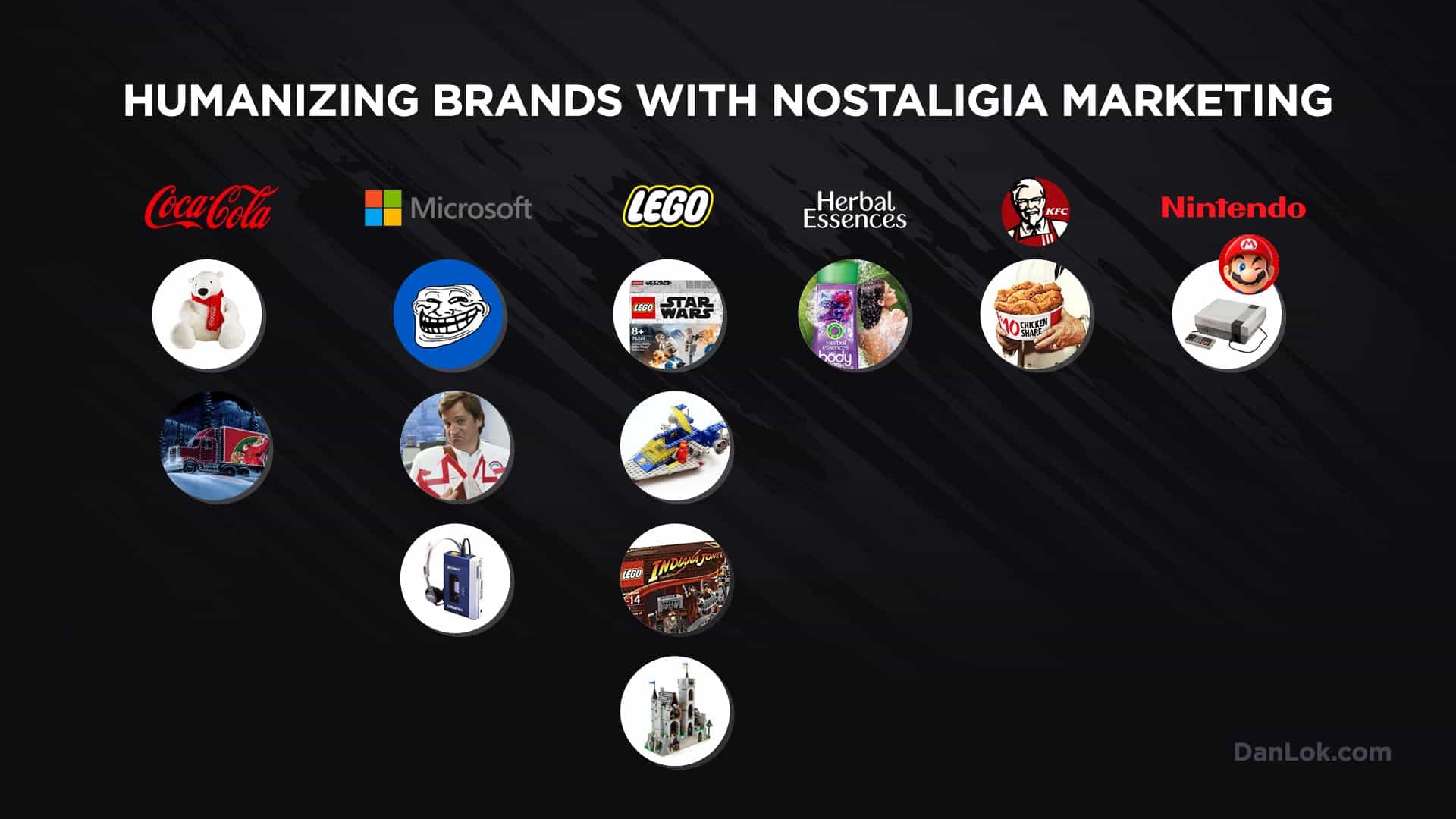
Pokemon Go capitalized on the nostalgia of Millennials who grew up playing Pokemon. Nintendo has relaunched and sold out a reboot of its 1980s classic console. Whatever industry you’re in, nostalgia marketing could probably work for you, too.
Schiemer and Carlson’s 2017 research in Nostalgia, irony and collectivity in late-modern culture: The ritual watching of The Disney Christmas Show in Scandinavia found that there has also been a resurgence in retro culture, with renewed interest in products like vinyl records, polaroid cameras, and the cars and fashion of bygone eras.
For Boomers and Gen X-ers these retro products could be personal nostalgia, as they have individual memories associated with them. For Millenials, the interest may stem from what is called historical nostalgia: a curiosity about an era they weren’t a part of, or a longing to be transported back to a different time.
It could also be a form of nostalgia that is more playful or ironic, where we find humour in the objects and fashions of the past. (Schiermer & Carlsen, 2017.)
How Can Your Business Take Advantage of the Power of Nostalgia?
Now that you know how nostalgia marketing works and how well it is working for Disney, the next question is: how can the rest of us capitalize on this phenomenon?
The lesson of Disney and some of the fan backlash demonstrates the importance of being genuine in your approach, or risk the perception of using nostalgia as a cash grab or out of creative laziness.
If you are attempting to drive sales using nostalgia, you should be careful with the tone you strike in using it. If it is overdone, then audiences and consumers will see through it and be turned off.
The key to using nostalgia is taking what is beloved from the past and subtly finding a way to harness those positive memories, while providing a product or experience that is still inventive and rewarding. Click To TweetSuccess comes not just from invoking any material or object from the past. It is essential to understand your demographic – what were they watching, playing with, listening to, and wearing in their formative years when preferences were developed?
There are no doubt many more products from the past few decades that are untapped nostalgic potential for creative marketers.
Savvy marketers will know how to use the ThrowBack Thursday and FlashBack Friday (#TBT and #FBF) hashtags on social media to promote their retro or nostalgic products, and tap into online trends.
Designs, logos, and slogans from the past can be used to stir up the ‘good old days’ memories of consumers. In general, brand logos with a retro design could generate positive emotions on their own, without even seeing what the product is yet.
Summary
Disney broke a world record in box office sales this year, and it’s largely to do with its nostalgia marketing strategy, involving the remakes of classic Disney movies.
The decision to buy something is largely driven by emotion, and nostalgia is an example of a positive emotion that influences purchasing decisions.
It’s really simple, isn’t it? We want to buy what we think will make us comfortable and happy.
Brands that can draw us in with nostalgia result in us connecting their products with our past memories and our more positive sense of self.
Brands like Disney that have mastered the strategy of nostalgia marketing are reaping the rewards in sales and brand loyalty.
Often when we think of business, we think of brand new ideas. The research into and demonstrated the success of nostalgia marketing shows us that with some creativity and strategy, past sentiments can be great for business.
